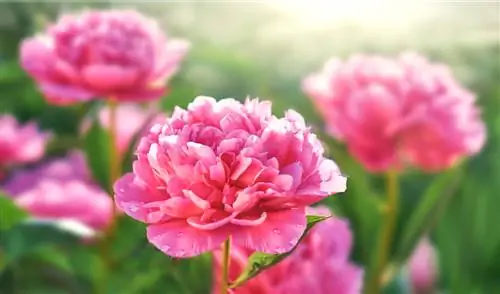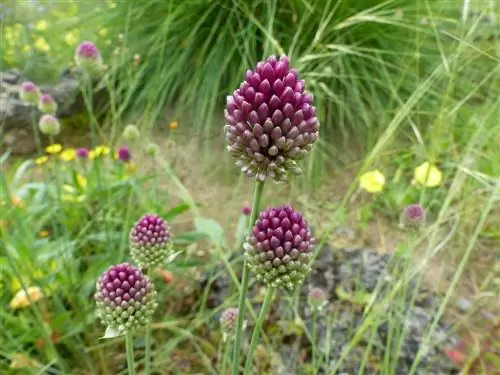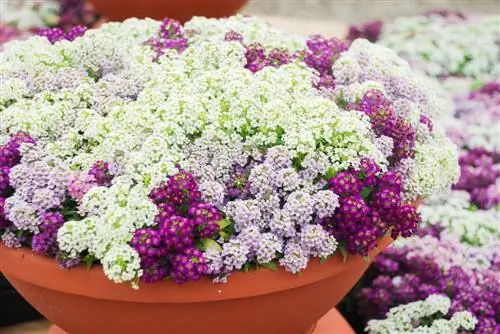- Author admin [email protected].
- Public 2023-12-25 17:45.
- Last modified 2025-01-23 11:22.
With a breathtaking presence, hostas transform shady to semi-shady garden locations into green islands of opulence. When the fragrant flowers appear in summer, the ornamental foliage perennials leave nothing to be desired. If you still have unanswered questions about caring for and planting Hosta, you can read the answers here.

How do you care for hostas properly?
Funkas are easy-care foliage perennials that prefer semi-shady to shady locations. For optimal growth, they need fresh, moist, humus-rich and nutrient-rich soil. They should be watered and fertilized regularly during the growing season. In winter they pull back their leaves to gather strength for the next shoot.
Planting hosta correctly
With professional planting, you can set hosta cultivation on the road to success right from the start. The semi-shady to shady location should have humus-rich, deep, loose and fresh, moist soil. Since hostas thrive in small groups, create several planting pits at least 50 cm apart. Mix compost, horn shavings or leaf mold into the excavation. It is advantageous to line the pit with nettle leaves. During this preparatory work, the still potted root ball is soaked in soft rainwater in a container. The planting then proceeds like this:
- Unpot the young sweetheart lily, position it in the middle of the planting hole and plant with the soil mixture
- After watering with lime-free water, spread a layer of mulch made of leaves or bark mulch
- In the following days, water regularly and generously
In the pot, hostas unfold their decorative leaf decorations equally. In this case, add additional drainage made of pottery shards, which is spread out about 5 cm high between the substrate and the water drain. To prevent the material from immediately becoming muddy again, place an air- and water-permeable piece of fleece over the clay shards.read more
Care tips
The care program for a hosta requires little from the gardener. We have put together all the important measures for you below:
- Keep the substrate constantly moist, preferably with soft, lime-free water
- Fertilize organically in the bed in March and June, in the pot every 30 days with liquid fertilizer
- Cut off withered flowers as soon as possible and simply pluck out withered leaves
- Complete pruning either in autumn or late winter
In the first two years of existence, hostas are still trying to establish themselves firmly in the soil. Since winter hardiness is not yet fully developed at this time, cover the root disc with leaves, bark mulch or coniferous twigs. The retracted leaves remain on the hosta as a winter coat, preferably until February/March.
Which location is suitable?
Anyone who forces Hosta into the tight corset of pure shade plants is doing the wasteful perennials an injustice. In fact, the magnificently marked leaves achieve an incomparable luminosity the more sun rays pass over them. Only the bright midday sun causes the pretty leaves to burn. This is what the location for hostas should be like:
- Sunny without direct sun, partially shaded to shady
- Happy with sun in the morning or evening hours
- Fresh, moist soil without the risk of waterlogging
- Humos, loose, nutritious and slightly acidic to neutral
A hosta feels at home in the light shade under the high canopy of mighty trees. At the edge of your private water world, hostas like to have a decorative dialogue with tall ornamental grasses and ferns that catch the blazing rays of the sun.
The correct planting distance
The multifaceted Hosta genus presents us with magnificent species in a wide variety of heights and widths. For better orientation, we have listed recommended planting distances for the most common hostas here:
- Miniature hosta with heights of 10-15 cm: planting distance 10 cm
- Classic with heights of 40-80 cm: planting distance 90 cm
- Hosta giants with heights of 100-150 cm: planting distance 150 cm
When deciding on the distances, please keep in mind that slow-growing hostas increase in volume over the years and thrive over space. If in doubt, choose a larger planting distance rather than making it too tight.
What soil does the plant need?
In order to produce the brilliant biomass of decorative leaves, a nutrient-rich, deeply humus-rich soil is required, richly populated by vital soil organisms. In addition, a balanced moisture content is extremely relevant to motivate hosta to perform at their best. Last but not least, please pay attention to the soil acidity value, because a slightly acidic to neutral pH value rounds off the optimal conditions.
When is flowering time?
Depending on the Hosta species and variety chosen, the bell or flower spikes thrive from June to July or from July to October. Although the flowers' visual effect takes a backseat to the decorative leaves, they are ideal for cutting into vases. Hosta flowers and leaves are in great demand among creative florists in order to conjure up imaginative bouquets and arrangements.
Cut hosta correctly
Hosta do not insist on shape and maintenance pruning in the actual sense. Hobby gardeners with limited time simply give hostas free rein. Nevertheless, the professional use of the scissors at the right time contributes to the spectacular habitus. Hostas should be cut on these occasions:
- Cut newly bloomed stems for the vase or arrangements
- Cut out wilted flowers regularly to prevent seed growth
- It is better to pluck out individual withered leaves instead of cutting them off
- Prune close to the ground in February/March, in good time before the new shoots
read more
Watering hosta
One of the fundamental factors of competent hosta care is a constant water supply. Don't let a sweetheart lily go thirsty at any time of the year if you don't want to incur their displeasure. Ideally, you should apply soft rainwater directly to the root disc. Do not pour the water into the heart of the plant, otherwise rot will spread.
Fertilize the hosta properly
The easy-care handling of a hosta is based not least on the uncomplicated supply of nutrients. Fertilize the gem with compost in March and June. A few handfuls of horn shavings provide the necessary nitrogen. Cultivated in a bucket, pamper Hosta every 30 days from April to July with a commercially available liquid fertilizer (€10.00 on Amazon).
Wintering
Every winter, hostas pull in their decorative leaves to gather strength for fresh growth next year. The withered leaves remain on the hosta until February/March as natural winter protection. In the first two years of growth, we recommend additionally piling up the planting site with leaf mold, peat or pine twigs up to the root neck. It is not absolutely necessary to cut off the plant remains. If the sight bothers you, cut the perennial just above the ground and dispose of it in the compost.
Hosta in pots receive protection from frosty temperatures every year. Cover the container with bubble wrap and place it on a wooden block. The substrate is covered with autumn leaves or pine needles. Water the perennial during winter droughts so that the root ball is not damaged.read more
Propagate hosta
If you're passionate about hostas, you'll want more specimens of this impressive leafy perennial. How good that propagation is effortless. The best time is in February/March, after pruning and before new growth appears. How to do it right:
- Lift the sweetheart lily out of the ground over a large area
- Cut out old, stunted areas
- Place on a solid surface to cut the rhizome into two or more pieces
While maintaining the previous planting depth, place each Hosta segment in the partially shaded to shady location in the garden soil enriched with compost. In the following weeks, regular water supply is essential for root growth.
How do I transplant correctly?
If the hosta takes on an undesirable volume or you have ordered the plants to change location, the plan can easily be put into action in February/March. First loosen the root ball with the digging fork and then lift it out of the ground with the spade. Now is the ideal opportunity for division and rejuvenation. Cut off any bare pieces and, if necessary, cut the root ball in half. At the new location, dig the planting pit deep enough so that the previous planting depth can be maintained. The soil is optimized with compost and horn shavings before you plant and water the rejuvenated hosta.read more
Funkie in a pot
Apart from the Hosta giants, all common hostas demonstrate their decorative presence in large pots. So that you can enjoy the leafy perennial for many years, a semi-shady location on the balcony is primarily an option. A structurally stable potted plant soil gives the mighty plant sufficient support, while drainage made of pottery shards prevents harmful waterlogging. The following aspects are of crucial relevance in nursing:
- If the substrate dries, watering is carried out thoroughly
- Empty a coaster after 20 minutes at the latest
- Fertilize liquidly every 4 weeks from April to July
- Cut off withered flowers, pluck out withered leaves
- Pruning close to the ground either in autumn or February/March
If winter sets in, wrap the pot in bubble wrap or jute and place it on wood. The substrate is covered with leaves or pine needles. Water the sweetheart lily even in winter so that the root ball does not dry out.
Is hosta poisonous?
The botanical assignment of Hosta to the asparagus family already signals its safety. Hostas pose no danger to humans or animals. On the contrary, the flowers are very popular in Asia as a culinary snack between meals. This aspect also means that you can safely avoid wearing work gloves.
Beautiful varieties
Expert breeders have generated more than 4,000 enchanting varieties from the more than 40 magnificent hosta species. The following overview shows a selection of selected Hosta treasures for the private green realm.
- Super Sagae: Green decorative leaves, as if chiseled with creamy yellow edges and purple panicle flowers; Growth height 75-85 cm
- Abba Dabba Do: Majestic gold-edged hosta with light lavender flowers that tolerates sun; Growth height 50-90 cm
- Fragrant sweetheart lily: It adorns the scented garden in semi-shady to shady locations with an intoxicating scent; Growth height 30-70 cm
- Elegans: Top-class blue-leaf hosta with white-purple bell-shaped flowers and blue-green, veined foliage; Growth height 70 cm
- Blue Cadet; Dainty counterpart to Elegans that thrives in hemispherical cushions; ideal for the bucket; Growth height 30-40 cm
- Empress Wu: Hosta colossus with a wingspan of up to 2 m, huge decorative leaves and delicate purple flowers; Growth height 120-150 cm
- El Nino: Premium variety that leaves nothing to be desired with cool blue leaves and white-purple flowers; Growth height 40-50 cm
- Gold Standard: Unrivaled luminosity with gold-green leaves under purple bell flowers in June; Growth height 30-80 cm






